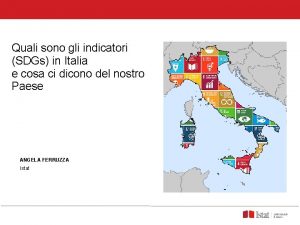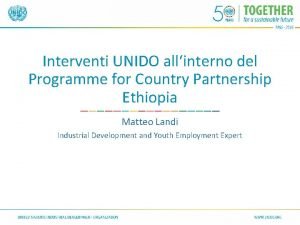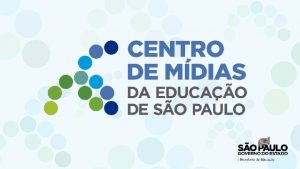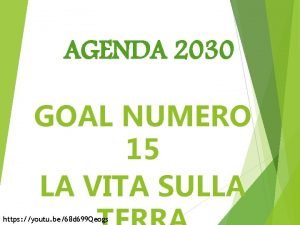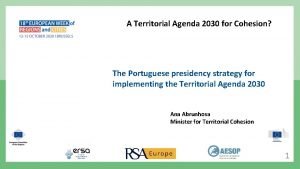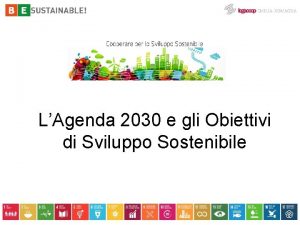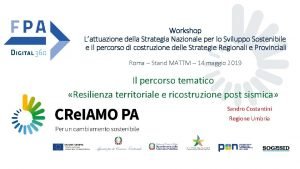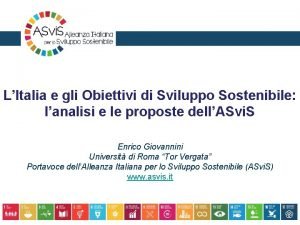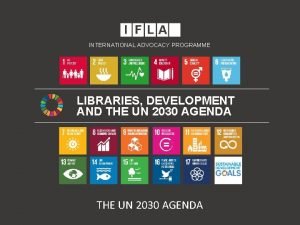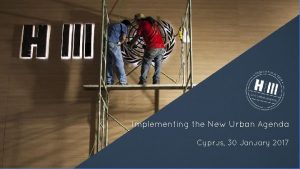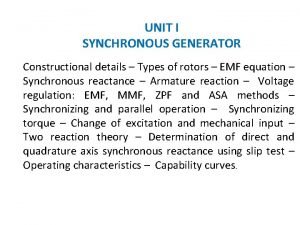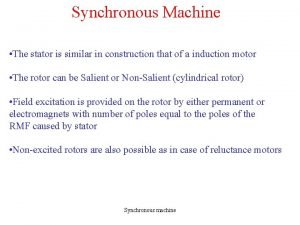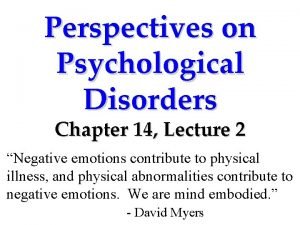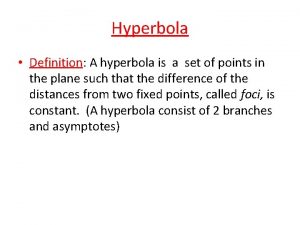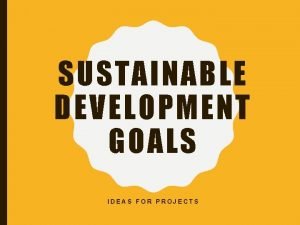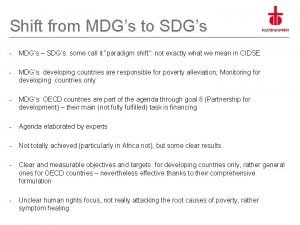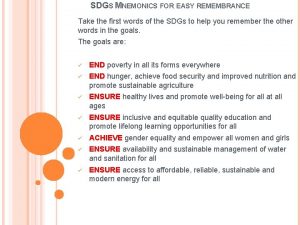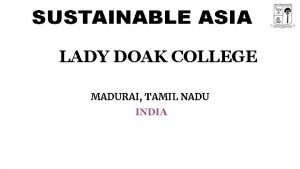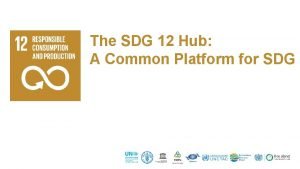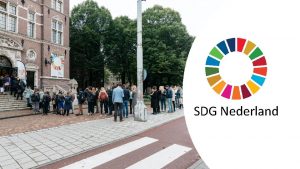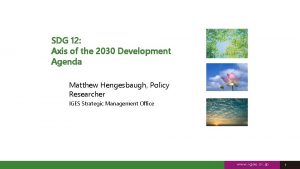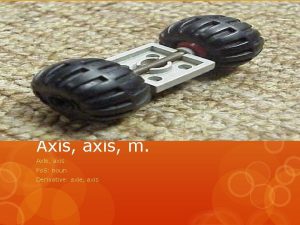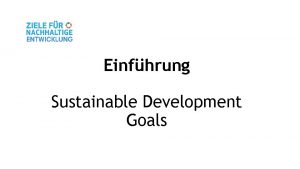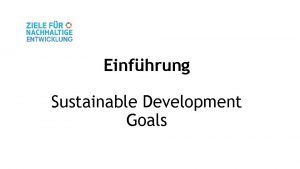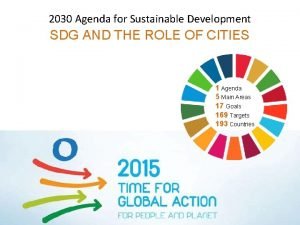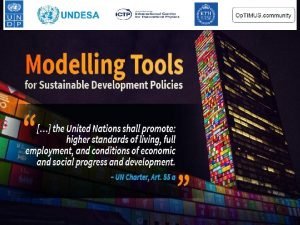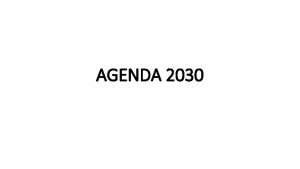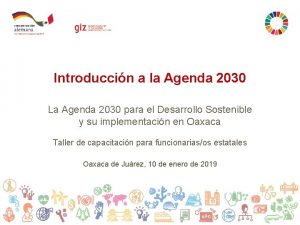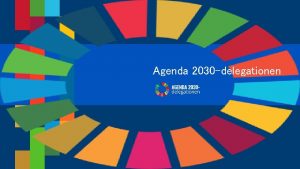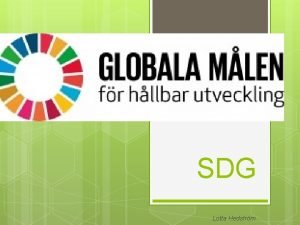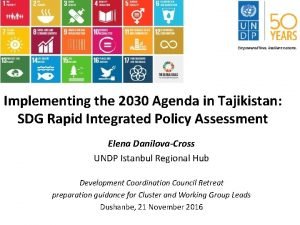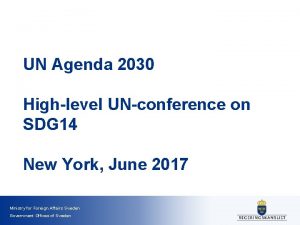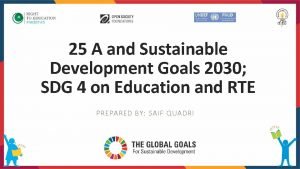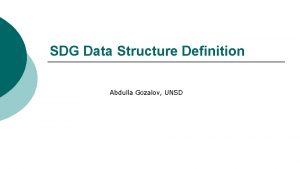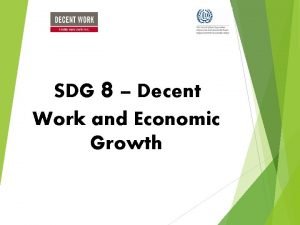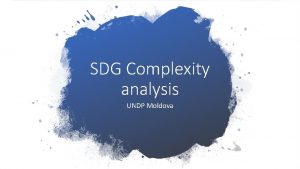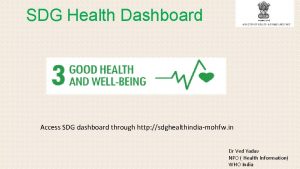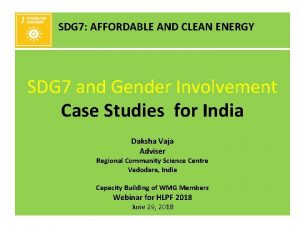SDG 12 Axis of the 2030 Development Agenda
























- Slides: 24

SDG 12: Axis of the 2030 Development Agenda Matthew Hengesbaugh, Policy Researcher IGES Strategic Management Office 11

Presentation Outline 1. Conceptual Framework of SCP 2. History of SCP 3. SDG 12: Targets and Indicators 4. Linkages with the Sustainable Development Goals (SDGs) 5. Case studies 6. Challenges and Opportunities 22

Sustainable Consumption and Production 33

Why SCP? Resource Challenges for Asia & the Pacific • UNEP’s GEO-6 Report: Regional Assessment for Asia & the Pacific (2016) indicated that the region’s material consumption accounted for more than 50 percent of global consumption in 2015. • Further, UNEP (2011) confirmed that material resource consumption would increase 3 times in 2050 compared to 2005 in Asia-Pacific region. • Even if resource and energy efficiency increase by 50%, resource consumption continues to expand with supply demands. • Therefore, developing economies need to increase its resource efficiency on the one hand; developed economies need to shift policy and investment for systems innovation towards decreasing resource consumption. 4 Source:Figure 7. 5, UNEP(2011), Resource Efficiency: Economy and Outlook and the Pacific, P. 171. 44

Need collaboration with non-G 7 for RE as global agenda Per capita consumption of some of BRIICS is higher BRIICS G 7 Source: Aoki-Suzuki based on OECD stats 55

Sustainable Consumption and Production: Conceptual Framework Source: http: //www. unep. org/resourceefficiency/Home/Whatis. SCP/tabid/105 574/Default. aspx Source: http: //www. wrap. org. uk/about-us/about/wrap-and-circular-economy 66

Development of SCP 77

History of SCP 1972 Limits of Growth 1987 WCED 1992 UNCED 2002 WSSD 2003 Marrakech Process 2012 Rio+20 2015 Agenda 2030 EVOLVING CONCEPTS AND DEFINITIONS 88

10 Year Framework of Sustainable Consumption and Production (10 YFP) • Background • Prepared since 2002, adopted at Rio+20 • Objectives • Supporting policies and initiatives; Capacity building; Knowledge Sharing • 6 Programmes • • • Sustainable Public Procurement Consumer Information Sustainable Tourism including Ecotourism Sustainable Lifestyles and Education (co-led by MOEJ, Sweden, WWF) Sustainable Building and Construction Sustainable Food Systems 99

Background on the SDGs The sustainable development and human development tracks merge over time 10 10

Interrelationship with other SDGs Source: http: //wasteaid. org. uk/wast e-sustainable developmentgoals/ 11 11

Holistic and Integrated Approaches Source: http: //www. resourcepanel. org/reports/assessing-global-resource-use 12 12

Holistic and Integrated Approaches Source: http: //www. resourcepanel. org/reports/assessing-global-resource-use 13 13

SDG 12: Targets and Indicators 14 14

SDG 12: Ensure Sustainable Consumption and Production Patterns 15 15

SDG 12: Ensure Sustainable Consumption and Production Patterns 16 16

Case Studies 17 17

Case Study: Kitakyushu City, Japan 18 18

Case Study: SCP Policies at the National Level Supporting bilateral collaboration between MOEJ and Malaysia “Collaborative Project for the Development of National Strategic Plan for Food Waste Management in Malaysia” Agreement for the collaborative project JPSPN, MHLG, Malaysia Supporting institutions ・JGPSSI ・PPSPPA ・PEMANDU ・Municipalities ・Universities etc. 1. Legal framework • Develop the food waste management regulation National Coordinator MOEJ, Japan Commissioned (FY 2010) Collaborative partner IGES partly re-commissioned (FY 2010) <Project Contents> 2. Large-scale organic waste treatment plant (financed by Malaysian government) • Analyze cost-sharing mechanism 3. Scaling-up and expansion of successful cases • Composting pilot projects at local levels (municipalities, universities, etc. ) 19 19 19

Case Study: Ban Soon Heng SDN BHD (BSH), SWITCH-Asia • Private Malaysian company that develops, manufactures and sells clay pipes used in sewerage and drainage, installed in sewerage systems nationwide • Participated in Carbon Footprint Pilot Programme (March – Dec 2014) under Malaysia’s Sustainable Building Materials Programme • Partnership between SIRIM Berhad, Federation of Malaysian Manufacturers, Building Materials Distributors Association of Malaysia, Malaysian Green Building Confederation, and Carbon Trust Limited environmental awareness among employees Lack of guidance on cost savings during the manufacturing process Limited awareness about environmental impacts of manufacturing processes No waste management Before More environmental and climate change related awareness among employees Reduced electricity consumption and fuel usage Increased knowledge about environmental impacts Recycling and waste minimisation carried out Increased brand recognition and acceptance in the market After Source: http: //www. switch-asia. eu/fileadmin/user_upload/Publications/2015/Final_SCREEN_files. pdf

Challenges and Opportunities 21 21

Priority challenges for SCP policy/SDG 12 Government capacity and interagency collaboration is key • Need to emphasise resource efficiency and circulation as a high priority in national developmental strategies • Robust partnerships between relevant stakeholders are crucial from initial planning stages to the review of various policies and strategies • Cooperation and coordination among line-ministries is key for mainstreaming resource circulation and SCP policies Industrial infrastructure and technology transfer • Linking development of legislation and systematic development of industrial sector (facilities and technologies) for waste treatment and recycling of collected recyclables Well-organised recycling market • Recycling mechanisms that use economic instruments such as EPR for specific end-of-life products would help shift from informal dirty recycling to a well-organised market with stable job opportunities. 22 22

12 Emerging Opportunities for SCP/SDG 12 1. Consumption of experience matters more for happiness of people in the long run 4. Measurement of society’s genuine wealth is important for policy making 7. Role of digital technologies: Io. T, AI 10. Sharing economy is an important entry point 2. Alignment with Paris Climate Agreement and Environmental, Social Governance (ESG) investments 5. Concepts of circular economy and sustainable value chains 8. Urban planning and infrastructure development is crucial 11. Recognition of implicit rules and customs 3. Evolving guidance on tailoring information for behaviour change 6. Product design should address people’s needs in their local context 9. Importance of local wisdom and indigenous knowledge 12. Multistakeholder partnerships is a key to success Source http: //www. susdesign. t. u-tokyo. ac. jp/s-16/docs/policybrief_A 4_180706. pdf

Thank you for your attention! 24 24
 Agenda 2030
Agenda 2030 Agenda 2030
Agenda 2030 Agenda 2030 geografia
Agenda 2030 geografia Agenda 2030 numero 15
Agenda 2030 numero 15 Territorial agenda 2030
Territorial agenda 2030 Consumo e produzione responsabile agenda 2030
Consumo e produzione responsabile agenda 2030 Italia agenda 2030
Italia agenda 2030 Agenda 2030 pl
Agenda 2030 pl Schema agenda 2030
Schema agenda 2030 Twitterifla
Twitterifla Agenda 2030
Agenda 2030 Agenda 2030
Agenda 2030 Impedence method
Impedence method Advantages of self control synchronous motor
Advantages of self control synchronous motor Axis 1 and axis 2 disorders
Axis 1 and axis 2 disorders Vertical hyperbola equation
Vertical hyperbola equation Conic sections table
Conic sections table Personality disorder vs mental illness
Personality disorder vs mental illness Agenda sistemica y agenda institucional
Agenda sistemica y agenda institucional Sustainable development project ideas
Sustainable development project ideas Why shift from mdg to sdg
Why shift from mdg to sdg Sustainable development goals mnemonic
Sustainable development goals mnemonic Doak meaning in tamil
Doak meaning in tamil Sdg 12 hub
Sdg 12 hub Sdg nederland
Sdg nederland
